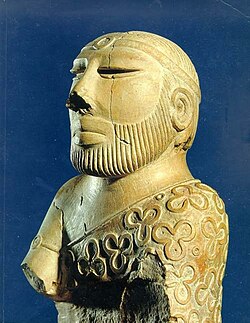Greco-Bactrian Kingdom
| History of Pakistan |
|---|
| Timeline |
|
|
|
|
Early modern
|
|
Modern
|
|
History of provinces
|
The Greco-Bactrian Kingdom was the eastern-most tip of the Ancient Greek world. It lasted between 250-125BC. It covered Afghanistan, Tajikistan, Uzbekistan and Turkmenistan. It covered a region originally conquered by Alexander the Great. The Inhabitants were called Indo-Greeks.
Greco-Bactrian Kingdom Media
Corinthian capital, found at Ai-Khanoum, 2nd century BC
Coin depicting the Greco-Bactrian king Euthydemus, 230–200 BC. The reverse shows Heracles seated, holding club in right hand. The Greek inscription reads: ΒΑΣΙΛΕΩΣ ΕΥΘΥΔΗΜΟΥ, Basileōs Euthydēmou – "(of) King Euthydemus".
Bilingual coin of Eucratides I in the Indian standard, on the obverse Greek inscription reads: ΒΑΣΙΛΕΩΣ ΜΕΓΑΛΟΥ ΕΥΚΡΑΤΙΔΟΥ, Basileōs Megalou Eukratidou – "(of) Great King Eucratides"; on the reverse Pali language in Kharoshthi legend reads: Maharajasa Evukratidasa, "of Great King Eucratides".
Gold 20-stater of Eucratides I, the largest gold coin of Antiquity. The coin weighs 169.2 grams, and has a diameter of 58 millimeters. The reverse shows the Dioscuri on horseback.
Gold artefacts of the Scythians in Bactria, at the site of Tillia tepe
Silver coin of Plato of Bactria, wearing a diadem. The reverse shows Helios on his chariot facing forward. Greek legend reads: ΒΑΣΙΛΕΩΣ ΕΠΙΦΑΝΟΥΣ ΠΛΑΤΩΝΟΣ, Basileōs Epiphanous Platōnos – "(of) King Plato the God-Manifest."
Sources
Much of our information comes from the Roman Strabo. Much archaeology has been done in Afghanistan, especially in the cities of Aï Khanoum and Begram.
Exhibitions
The National Museum of Afghanistan has put on a touring exhibition about this kingdom. It has been shown at the British Museum and also in France, Germany and the Netherlands. Much other archaeology is on display in the Hermitage Museum in St. Petersburg, Russia.









